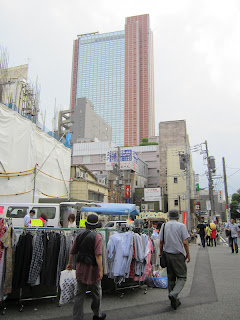2012-06-24
Sangenjaya: June 24, 2012
Sangenjaya is one of major terminals in Setagaya Ward, western Tokyo. It is about four kilometer west from Shibuya.
We find both old and new faces of the town like other terminals,
There are old shopping areas in several places in the area. There also spread newly-developed buildings. 27-story Carrot Tower is a landmark of the town and is a good example of new faces of Sangenjaya. The tower is so called as its outside is carrot color.
They hold open-air market every weekend. I found Carrot Tower behind the market.
I visited Setagaya Park about 15 minute walk from Sangenjaya. People enjoyed the sunshine on the lawn.
2012-06-23
Hydrangea @ Fuchu Open Air museum: June 23, 2012
Ask me the images of June in Tokyo. The answers may include rain, the summer solstice, firefly and hydrangea, not June bride or father’s day.
Today was fortunately a fine day (though it is still rainy season in Tokyo), so I visited Fuchu-no-mori open air museum in Fuchu City to enjoy hydrangea today.
There are about 10 thousands of hydrangea plants in the place. Purple, blue, pink and white flowers were fully open. I found various kinds of hydrangea flowers.
 Fuchu is about 20 km west from Shinjuku, Tokyo’s largest commercial area. The capital of Musashi country was placed here in the 7th century. The city is famous for Tokyo Racecourse and Okunitama Shrine.
Fuchu is about 20 km west from Shinjuku, Tokyo’s largest commercial area. The capital of Musashi country was placed here in the 7th century. The city is famous for Tokyo Racecourse and Okunitama Shrine.It is midsummer season. We have about 12 and half hours of daylight in Tokyo at this season. The sun rose at 4:25 am and set at 7:00 pm on June 21, the summer solstice day, according to the Meteorological Agency.
2012-06-10
Iris Fields @ Meiji Shrine: June 10, 2012
Rainy season began in Tokyo.
Japanese people traditionally enjoy iris in this season the season. I visited Meiji Shrine’s iris fields.
Hundreds of purple, light purple and white flowers were open in the wet fields.
There are three kinds of iris flowers in the fields. They are Ayame (Iris sanguine), Hana-shobu (Iris ensata var. ensata) and Kakitsubata (Iris laevigata).
It is easy for professionals to make difference between the three, but not for me.
The fields were made in the order of the Meiji Emperor. Many visitors enjoyed the flower.
I also walked around Meiji Shrine. There were many foreign and Japanese visitors as usual. It was also usual to see a wedding ceremony. They held a special Bonsai exhibition in the entrance space of the main shrine.
Subscribe to:
Posts (Atom)















